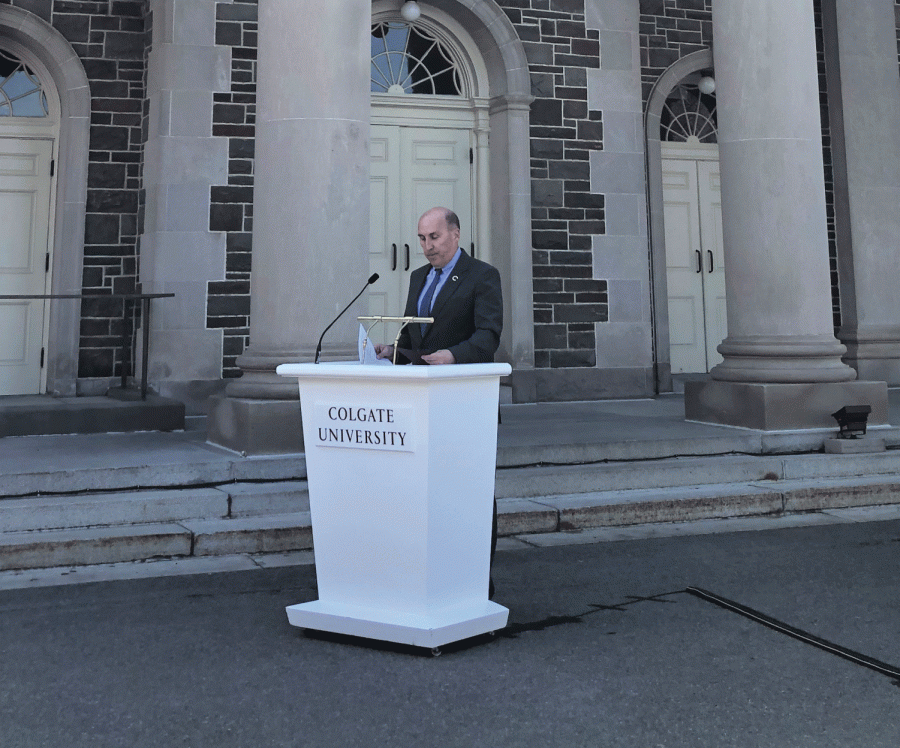Colgate Achieves Carbon Neutrality Goal
Colgate has officially completed its pledge, made in 2009, to reach carbon neutrality by 2019, its Bicentennial year, becoming the first university in New York State to do so. The achievement was formally announced on April 22, Earth Day, at an ice cream social celebrating Colgate sustainability.
President Brian Casey highlighted how far he believes Colgate’s commitment to sustainability has come over the years.
“Ten years ago, Colgate did not have an official sustainability program,” Casey said.
In 2009, Colgate hired John Pumilio as its first director of sustainability and committed to becoming carbon neutral by signing the Second Nature Carbon Commitment.
Casey acknowledged Pumilio for the role he has played in reducing Colgate’s carbon footprint since then, as well as everyone who has played a role in making Colgate more sustainable over the past ten years.
“Our university’s net carbon footprint is now zero,” Casey said. “This was a complex, multi-channel effort.”
Pumilio reflected on what he said he saw as a lack of dedication to sustainability when he was first hired to create a legitimate sustainability program at Colgate. According to the Office of Communications, Colgate’s carbon footprint was 17,353 tons at the time.
“Achieving carbon neutrality gives us reason to stop and reflect on our journey thus far,” Pumilio said. “A few years ago, Colgate University received a D+ on the College Sustainability Report Card. We were the worst in class.”
Pumilio said that at the time, Colgate was not actively measuring their carbon footprint, had little insight into their contribution to climate change and lacked a strategy to reduce their impact.
“We had no idea how much local food we were purchasing and we had no student-run organic vegetable garden. Our 1,000 acres of forest were not protected or managed for carbon sequestration. We didn’t have any renewable solar energy or geothermal installations. We didn’t have very many recycling bins on campus, no composting program and we did not recycle any of our used electronics. We didn’t have any certified green buildings and we didn’t have a grasp on how much energy, water or other resources went into operating our campus,” Pumilio said.
Since then, Colgate has taken steps to reduce their carbon footprint by reducing overall emissions. In 2010, the Colgate Community Garden broke ground and the university began working with their campus food provider on campus to source local food. Colgate earned its first LEED Gold certified building with the construction of Trudy Fitness Center in 2011. In the years following Trudy’s construction, Colgate has developed more environmentally conscious buildings, such as the construction of Benton Hall in 2018, the first of Colgate’s buildings to achieve LEED Platinum status.
In 2013, new solar arrays were installed on a residence hall and 2016 saw installation of Colgate’s first geothermal heating and cooling system on campus.
In addition to reducing emissions, Colgate also began working with Patagonia Sur in 2012 to create a carbon-offset and research program that would acknowledge emissions not being reduced.
In 2019, Colgate invested about $60,000 in carbon offsets to account for emissions coming from employee travel, heating and cooling.
Bob Turner, the chair of the Sustainability Council at Colgate, said that Colgate has committed both to reducing their overall emissions and offsetting them where they can.
“We have reduced direct carbon emissions by a huge percentage and, importantly, we have taken responsibility for all of the rest of our emissions by purchasing offsets with significant co-benefits of various kinds,” Turner said.
Additionally, Colgate established the Green Revolving Loan Fund in 2017 as a 1.25 million dollar self-sustaining fund for continued energy and carbon-reduction projects.
According to the Office of Communications, as a result of these efforts over the past ten years, Colgate’s total carbon footprint has decreased from 17,353 tons to zero and emissions have been reduced by 46 percent.
Senior Maddie Smith, a Colgate sustainability intern, said that Colgate is not done improving its sustainability now that carbon neutrality has been reached.
“Just because Colgate is now carbon neutral does not mean we can get complacent,” Smith said.
President Casey echoed this sentiment, looking to the future of Colgate sustainability.
“We must continue to give our students the tools they need to grapple with the inevitability of climate change,” he said. “Our past suggests that we will do this, and our future demands that we do more.”
Smith also expressed hope that Colgate’s efforts will inspire other institutions to improve their sustainability efforts as well.
“I am hopeful that Colgate will have a trickle effect across other institutions,” Smith said.
Contact Karrie Spychalski at [email protected].







